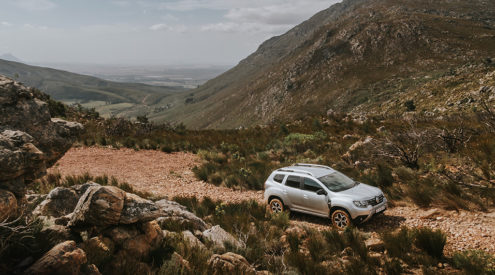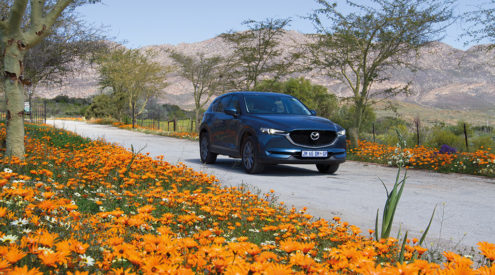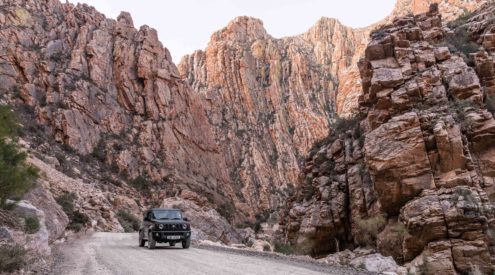International travel magazines are touting off-the-grid Namibia as one of the world’s most alluring places to visit (one example: Namibia made Travel+Leisure’s Top 50 list for 2019). But we South Africans have known this for decades – we just call it camping. And camping in Kaokoland (also known as the Kunene Region) is just about as off-the-grid as you can get.
‘You are going to eat dust,’ said Danie ‘Jakkals’ van Ellewee. Jakkals was delivering a Saturday sermon on the banks of the Kunene River to 12 of us, mainly South Africans and a Dutch couple, hellbent on exploring some of Namibia’s remotest roads, rivers and rugged terrain.

Twelve of us set off to explore some of Namibia’s remotest roads, rivers and rugged terrain. Image credit: Melanie van Zyl
With the world’s most popular places dealing with over-tourism, Namibia (as one of the least populated in the world) has become a drawcard for those seeking solitude. So it’s no wonder that Kaokoland is trending as an off-grid hotspot and an antidote to overcrowding.
However, it’s precisely this inaccessibility that can make a trip here feel daunting – this is where Jakkals of Live the Journey and his crew, Andre Richards and Lukas Ngenohame, come in. Their Seven Rivers Tour is for travellers who want to drive their own vehicles but have backup in case they need it. The company provides recovery, expert 4×4 guidance, good food, local knowledge of history, birds and trees, plus great jokes.
On the first morning at Kunene River Lodge (Angola is just across the river), Jakkals talked to us about two-way radio etiquette (each car was kitted out with one), the correct following distance, backup protocol, stopping for Kodak moments, correct tyre pressures and recovery tactics. He ended by promising us the trip of a lifetime across Kaokoland.

The view from Melanie’s tent on the banks of the Kunene River, which forms the border with the Angola. Image credit Melanie van Zyl
Namibia is not known for its abundance of water, but a number of seasonal rivers cut through this parched land. Over 10 days, we’d cross seven major ones that are lifelines to the north: the Kunene, Khumib, Hoarusib, Hoanib, Huab, Aba-Huab and Ugab. We would also tackle the notorious Van Zyl’s Pass and visit Twyfelfontein, a World Heritage Site.
It was Jakkals’s first time taking a Van Zyl (me) over the pass, but this was by no means the crew’s first rodeo. Their expertise is why people like me and Johann Venter were on the tour.
‘I chose to join this group so I wouldn’t have to tackle it alone,’ said Johann, owner of a Toyota Hilux. ‘I’m getting a bit old to change these big tyres by myself!’
Rock tyres are a must out here. Plus two spares, for good reason. We were all apprehensive about attempting the pass.
‘I read it can break both cars and nerves,’ said Joe de Jager from Cape Town.
‘Just don’t look at your back right tyre,’ piped up Andre, while stirring a pot for supper. ‘It’s always a metre higher than you think it is.’
It was hard to imagine that such treacherous terrain lay ahead, given the serenity of my setting – the Kunene owing languidly past my tent.

Baobabs cling to the cliffs of the Epupa Falls, where the Kunene River drops into a series of cascades down a 40-metre-high gorge. Image credit Melanie van Zyl
Although Kaokoland is not protected in a traditional national-park sense, it is secured by a network of registered, communal conservancies, which are selfgoverning, democratic entities run by their members. This area has the highest concentration in Namibia, with 38 registered groups and a membership of 50,455. Most nights we slept in community-run campsites adjacent to homesteads of the Himba (one of the last semi-nomadic, desert-dwelling groups in Africa), sharing their wilderness and water.
Leaving our camp behind on the fourth day, Jakkals guided us onto Van Zyl’s Pass. ‘Here, we need to climb slowly, like a mouse in slippers,‘ he called over the radio.
‘Keep it on low range and engage the diff lock.’ The 12-kilometre stretch, passing bulbous-based Kaokoland sesame trees, goats and cattle, went by relatively smoothly and quickly, with one scary moment when the loose, stony gravel slipped under our tyres. I gripped my door tightly until the vehicle righted itself! With some relief, we found that the pass wasn’t as tough as we’d expected. However, no one should underestimate the technicalities involved, and Jakkals and his crew were vital to our enjoying it.
Our safe passage down Van Zyl’s craggy slopes was in stark contrast to the at grasslands of the Marien uss Valley where we next found ourselves. Kaokoland is still one of the most intimidating wilderness areas in the world, yet here I discovered ethereality all the way south. ‘Fairy circles’, unexplained phenomena sometimes attributed to ants, have cookie-cut their way into the Marien uss plains, and just the day before we had driven through a landscape where broad-bellied baobabs clung to the sides of sheer cliffs carved out by Epupa Falls.
All the way we had spotted birds with Disney-like names, such as Cinderella waxbill and rosy-faced lovebird.

An evening spent camping in the wild in the Hoanib Valley, not far from the Hoanib riverbed. Right: Night time in Namibia’s Kaokoveld. Image credit Melanie van Zyl
As we ventured south, parallel to the Skeleton Coast, which was about 50 kilometres away, we were still at the mercy of the Atlantic Ocean. Eerie fog rolled in, bringing cool, damp mornings with it, and springboks pronking in the mist was another other worldly scene near Orupembe. On the route after Marien uss Valley, we had dropped into a few riverbeds (the Khumib, Hoarusib and Hoanib), where it was easy to forget that we were still in the desert.
Although these channels are dry for the most part, their apparent barrenness hides fecundity: linear oases slicing through desolation, yet host to an abundance of life. Enough water lies underground creating animal highways above. Lanky giraffes paraded on river ridges, and sometimes on cornering a bend we’d surprise an oryx, which scampered off in a whirl of dust.
We were in a place where desert-adapted lions and elephants trample the sandy streets made in riverbeds (the Hoanib was the most spectacular of them all). Surely this was the stuff of fairy tales? Yet this is where you’ll see these extraordinary beasts that thrive in desert conditions. So we kept our eyes peeled for the flick of a feline tail or the flap of an enormous ear.

Melanie enjoying an ice-cold Tafel Lager from the gas fridge at Orupembe.Image credit Melanie van Zyl
Namibia’s Narnia performance continued beyond the river boundaries in the form of the Lone Men of Kaokoland, life-size rock sculptures in the shape of humans, which mysteriously appeared in 2016. One named ‘Dapper Stapper’ is seen walking across a stony plain carrying a bundle tied to the end of a stick; another sits perched on the edge of a hill, reminiscent of Rodin’s ‘Thinker’.
Speaking of stones, the tour also took us to see the Dancing Kudu and the Lion Man at Twyfelfontein, which has a gallery of more than 5,000 individual gures – one of the largest concentrations of rock engravings in Africa. The kudu and lion gures and others were skillfully scraped into the rock between 6,000 and 2,000 years ago, and preserved by the dry weather conditions. If this is not a place of soul and, dare I say, marvellous sorcery, then let me convince you further.
During the day near Puros, the convoy stopped for lunch beside a clump of living fossils with olive-green tongues that clutched the stony ground. Welwitschia – I mean, there’s ‘witch’ and magic in the very name!

Don’t despair if you don’t catch sight of Namibia’s desert elephants in the riverbeds (it’s estimated about 200 individuals remain). You might have them as neighbours on your last night at Brandberg White Lady Lodge. Image credit: Melanie van Zyl
On the last day, while I was eating a cheese sandwich for lunch, I contemplated the enchanting scenes I had witnessed throughout the journey – from the waterfalls of the Kunene River and desert pachyderms to the Lone Men and springboks in the mist (which, by the way, have a secret of their own – they bear the Latin name Antidorcas marsupialis because they, like their Australian cousins, hide a little pouch-like pocket below the belly).
Jakkals cut through my reverie. ‘Out here you can see the future coming – and you still don’t worry about it,’ he said.
That afternoon we crossed into Damaraland and headed south, back home. I may have reluctantly ‘closed the wardrobe door’ on Kaokoland, but like the children who left the Kingdom of Narnia behind, I still dream about all the fantastical characters that live there.
Plan your Trip
Getting there
Drive your own vehicle to Ruacana in northern Namibia, or fly to Windhoek and hire a 4×4 (note that most companies won’t rent vehicles if you’re driving Van Zyl’s Pass).
Need to know
While some previous 4×4 experience is recommended, some of us didn’t have any and still managed – the guides are that good. The terrain requires a rugged, high-clearance 4×4 with diff lock and suitable tyres. Your host will advise you
of what recovery equipment is needed but essentials are a spade, tyre-pressure gauge, high-lift jack – and ensure your 4×4 has tow points front and rear. You also need to take your own camping gear, drinks and lunches for 10 days.
Medical insurance is essential.
The tour
It starts at Kunene River Lodge (fuel up at Ruacana for the 1 000km drive to Palmwag Lodge, as finding fuel is hitand- miss) and ends at Brandberg. We drove about 100km a day, and had a fairly chilled routine – breakfast at about 8am, leave by 9am and a stop for lunch on the road. We’d usually reach camp before 4pm. The next tour this year is on 5–15 September.
The cost
The 10-day Seven Rivers Tour costs R15 300 pp. This includes concession and camping fees, levies, trained guides, use of twoway radios, breakfasts and dinners, and camping facilities (a chemical toilet and shower – you need to supply your own water for it, though). 021-863-6400, livethejourney.co.za
Do this
See Epupa Falls at sunrise. There is no entry fee and it’s a short walk from the campsite. Drink a cold beer in the middle of nowhere. Rands are accepted in Namibia to buy drinks at Orupembe Shop 1 on day five (R17 a beer).
Pack a bird book and binoculars. Among many others, I ticked off : Monteiro’s hornbill, Temminck’s courser, Rüppell’s parrot and Rüppell’s korhaan. Binos are also handy when looking for desert lions in riverine scrub!
Visit Twyfelfontein. This World Heritage Site with its ancient rock art is an optional outing but the short (can be very hot), guided walk is worth it. Entry is R80 per person.
























